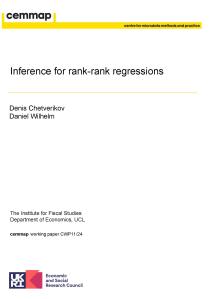Both direct utility function and Frisch cost function representations of demand system rank are derived. The results are used to construct a revealed preference (GARP) type test of rank. They are also used to derive results involving block separability, additive separability, and the class of all arbitrary direct utility functions (including Machina and other non-expected utility preferences) that are necessary and sufficient for portfolio separation and money separation. Some implications of these results are provided, including a generalization of the CAPM.
Authors

Research Associate Boston College
Arthur is a Research Associate of the IFS and holds the Barbara A. and Patrick E. Roche chair in economics at Boston College.
Working Paper details
- DOI
- 10.1920/wp.ifs.1996.9619
- Publisher
- IFS
Suggested citation
Lewbel, A. (1996). Demand system rank: direct utility, Garp tests and portfolio separation. London: IFS. Available at: https://ifs.org.uk/publications/demand-system-rank-direct-utility-garp-tests-and-portfolio-separation (accessed: 30 June 2024).
More from IFS
Understand this issue

Gender norms, violence and adolescent girls’ trajectories: Evidence from India
24 October 2022

What are the challenges in getting debt on a falling path?
28 June 2024

Election Special: Your questions answered
27 June 2024
Policy analysis

ABC of SV: Limited Information Likelihood Inference in Stochastic Volatility Jump-Diffusion Models
We develop novel methods for estimation and filtering of continuous-time models with stochastic volatility and jumps using so-called Approximate Bayesian Compu- tation which build likelihoods based on limited information.
12 August 2014

Assessing the economic benefits of education: reconciling microeconomic and macroeconomic approaches
This CAYT report discusses the strengths and limitations of several approaches to assessing the effect of education on productivity.
14 March 2013

Misreported schooling, multiple measures and returns to educational qualifications
We provide a number of contributions of policy, practical and methodological interest to the study of the returns to educational qualifications in the presence of misreporting.
1 February 2012
Academic research

Inference for rank-rank regressions
28 May 2024

Understanding Society: minimising selection biases in data collection using mobile apps
2 February 2024

The impact of labour demand shocks when occupational labour supplies are heterogeneous
28 June 2024